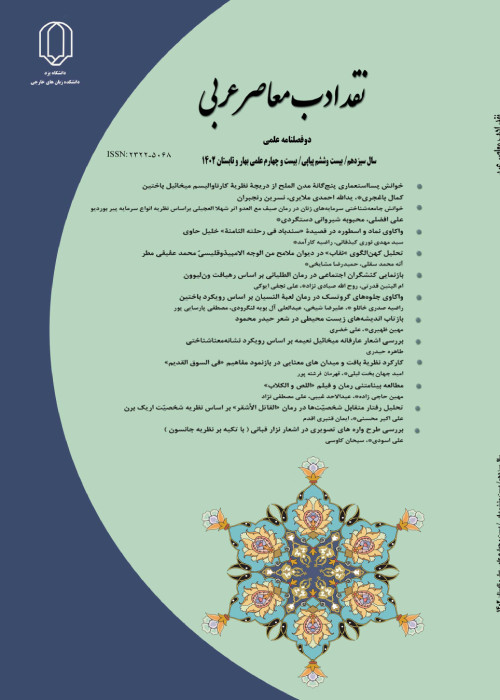The function of textual meta-functions in Ahmad Matar's poem Daur with Halliday's map-oriented linguistic approach
Author(s):
Article Type:
Research/Original Article (دارای رتبه معتبر)
Abstract:
Introduction
After Saussure, thanks to the efforts of Michael Halliday, structuralism went beyond the level of sentences and syntactic studies. He expanded the scopes of the text concept and textual context. Holliday evaluates the content system of all languages under the heading of meta-role (meta-function) at three levels including intellectual (experimental), interpersonal, and textual para-role, which together provide a deeper understanding of the text for the reader. Textual meta-function is the use of language to produce spoken or written texts that connect the meanings of two other meta-functions in a real context and consider their clause and type of arrangement to determine how well they shape the text.In recent years, many attempts have been made to study structuralism and Halliday's systematic pattern of literary works, which reveals the importance of linguistic patterns. Meanwhile, contemporary Arabic poetry, considering its new forms and themes, which are as a revolution in the direction of classical Arabic poetry forms and themes, can be a suitable platform for an analysis based on the patterns of Western linguistics. In this context, the present study examines the poem "Dour" by Ahmad Matar, a contemporary Iraqi poet, according to a systematic and patterned model of Halliday. The aim is to determine the degree of textual coherence, the effect of paragraphs in conveying meaning, and the poet's message.Methodology
From a meta-textual perspective, the construction of the beginning, the ending and the discourse information are considered as structural tools, and coherence is viewed as a non-structural tool of the text. In this approach, the relations between the clauses are divided into two types, external and internal. External relations (non-structural) under the title of coherence address the cohesive factors that connect the different parts of the text, which helps the reader or listener to understand the meaning. However, internal (structural) relations deal with the thematic structure and the information structure of discourse.In fact, the contextual function has to do with the initial construction, which is the extent and manner of structuring information by the speaker. Then, it concerns the informative construction, which is the amount of old and new information by the recipient and the relationship between the information presented and other discourse information.In this research, using a descriptive-analytical method and an linguistic approach, an attempt is made to study the main elements of textual meta-functions, which include textual coherence, beginning-ending construction and type of discourse information in the poem.Results and Discussion
According to the analysis of the poem, at the level of grammatical elements with 30.61% coherence and at the level of vocabulary with 57.14% coherence (which is the highest coherence in the poem), the poet often draws the audience's attention to four recurring elements including "al-Ghafia", "Arsh al-Taghia", "Jeld" and the poet. These have been mentioned in various forms. Finally, with the connecting elements that have the lowest degree of coherence in the poem, i.e., 12.24%, only a small expansion of the word, its detailed elaboration or a brief expression of time between paragraphs have been dealt with. Accordingly, with this level of coherence at the level of vocabulary and grammar, the poet first draws the audience's attention to the factors that somehow depict the meaning of the title of the poem; That is, the role of the poet and his poetry in overthrowing oppression. This is compared to the tanning of the skin of the throne of Taghut and is described with a concise expression.At the level of the construction of the beginning-ending as well as the type of discourse information, it is found that most of the clauses of this poem are unmarked and according to the rules of Arabic syntax and normal form of common sentences, which gives background information to the beginnings reading this poem. The presence of unnamed beginners with old information indicates that the poet did not seek to create complexity in his speech and wants to speak frankly and simply with his audience. Also, the statement nature of most of the verses indicates that the poet does not seek to challenge the audience or encourage them to protest or do similar actions to overthrow oppression. A poem with this type of construction seeks to inform the audience about the role of the poet and his rhyme.Conclusion
In general, according to the structural and non-structural analyses of the poem, the meaning of the title of the poem (i.e., Daur = role) becomes clear to the audience; That is, the roles of poet and poetry in overthrowing the throne of Taghut, a role that has been repeatedly mentioned due to the type of arrangement and information as well as the level of coherence. In fact, in this poem, the poet points to the effective role of writing in the development of people's consciousness, which, over time, achieves results and eliminates oppression.Keywords:
Language:
Persian
Published:
نشریه نقد ادب معاصر عربی, Volume:12 Issue: 23, 2023
Pages:
115 to 136
magiran.com/p2561473
دانلود و مطالعه متن این مقاله با یکی از روشهای زیر امکان پذیر است:
اشتراک شخصی
با عضویت و پرداخت آنلاین حق اشتراک یکساله به مبلغ 1,390,000ريال میتوانید 70 عنوان مطلب دانلود کنید!
اشتراک سازمانی
به کتابخانه دانشگاه یا محل کار خود پیشنهاد کنید تا اشتراک سازمانی این پایگاه را برای دسترسی نامحدود همه کاربران به متن مطالب تهیه نمایند!
توجه!
- حق عضویت دریافتی صرف حمایت از نشریات عضو و نگهداری، تکمیل و توسعه مگیران میشود.
- پرداخت حق اشتراک و دانلود مقالات اجازه بازنشر آن در سایر رسانههای چاپی و دیجیتال را به کاربر نمیدهد.
In order to view content subscription is required
Personal subscription
Subscribe magiran.com for 70 € euros via PayPal and download 70 articles during a year.
Organization subscription
Please contact us to subscribe your university or library for unlimited access!



